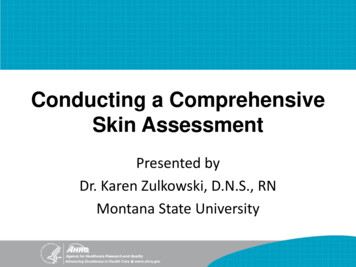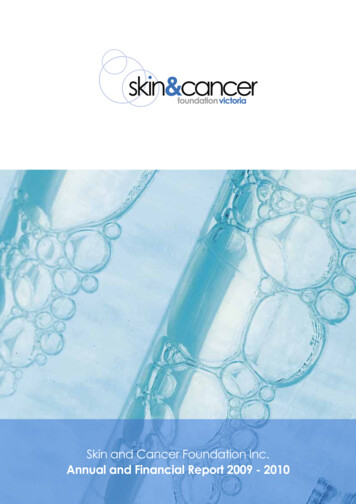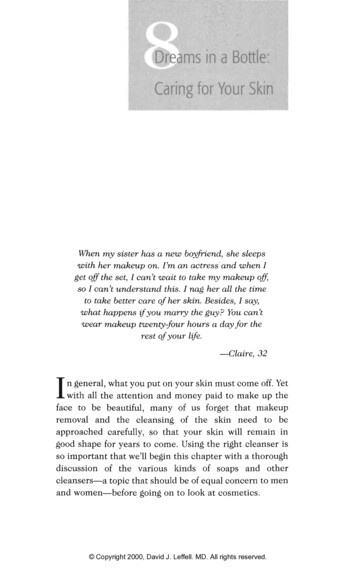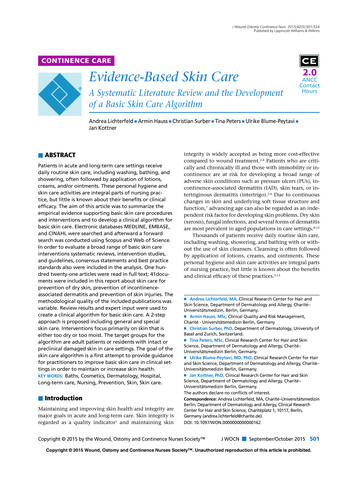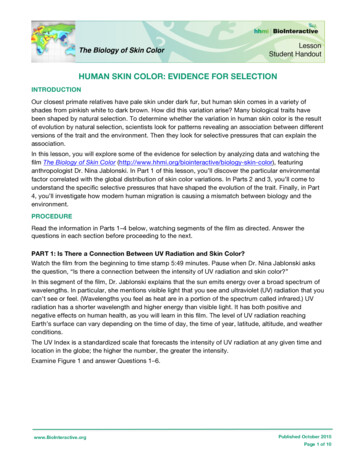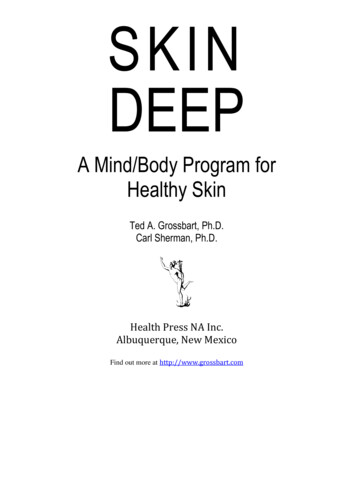
Transcription
SKINDEEPA Mind/Body Program forHealthy SkinTed A. Grossbart, Ph.D.Carl Sherman, Ph.D.Health Press NA Inc.Albuquerque, New MexicoFind out more at http://www.grossbart.com
To Selma Fraiberg:She brought light to so manykinds of darkness— T. G.To my mother— C. S.Copyright 1986 (First Edition) by Ted A. Grossbart, Ph.D.Copyright 1992 (Revised and Expanded Edition) by Ted A. Grossbart, Ph.D.Copyright 2009 (Digital Edition) by Ted A. Grossbart, Ph.D.Released for free under the Creative Commons Attribution-Share AlikeLicense 3.0Published by Health PressP.O. Box 37470Albuquerque, NM 87176-37470All rights reserved, including the right of reproduction in whole or in part in anyform. Printed in the United States of America96 95 94 93 9254Library of Congress Cataloging in Publication DataGrossbart, Ted A.Skin Deep : a mind/body program for healthy skin / Ted A.Grossbart and Carl Sherman. – 2nd ed.p. cm.Includes bibliographical references and index.ISBN 0-929173-11-2 (trade pbk.) : 14.951. Skin – Diseases – Psychosomatic aspects. 2. Mentalsuggestion.3. Hypnotism — Therapeutic use. 4. Mind and body.I. Sherman,Carl. II. Title.RL72.G76 1992616.5’08 — dc2092-23697CIPRevised and Expanded EditionISBN0-0929173-11-2ISBN 13 978-92173-11-5Edited by Denice A. AndersonCover design by Florence J. PleckiFind out more at http://www.grossbart.com
ContentsFOREWORDINTRODUCTIONTO FIRST EDITION, 1986INTRODUCTIONREVISED AND EXPANDED EDITION, 1992PREFACEACKNOWLEDGEMENTSFirst Edition, 1986Revised and Expanded Edition, 1992PART ONETHE STORYBEHINDYOURSKIN1 Your Skin: Sensing and Responding to the World Around You2 Listening To Your Skin3 Why Me?The Skin Has Its Reasons4. Why Now?5. Why There?Mapping Trouble Spots6. What Your Symptom Does For You7. What If It Got Better?What If It Got Worse?PART TWOWHATYOU CANDOABOUT IT8. The Healing State:Your Untapped Resource9 Reinforcements:More Techniques To Help Now10 Thinking: Enemy or Ally?11 Creating Beauty From Within12 Psychotherapy: Help in Depth13 Breaking the Itch-Scratch CyclePART THREEIS ITWORKING?14 Holding On/Letting Go:Your Symptom's Last Stand15 Ghosts:Find out more at http://www.grossbart.com
Have They Handcuffed Your Doctors?PART FOURDiseaseDirectory16 Disease Directory17 New Help for Alopecia18 The New Psychopsoriasis19 Warts and Herpes:A Tale of Two Sexually Transmitted DiseasesAPPENDIXESAPPENDIX IQUESTIONS AND ANSWERS ABOUT THE SKIN DEEP METHODAPPENDIX IISeeking Professional HelpAPPENDIX IIIThe Power of the GroupAPPENDIX IVSupport and Mutual Help Group DirectoryNOTESBIBLIOGRAPHYABOUT THE AUTHORSFind out more at http://www.grossbart.com
Introduction To The FreeeBookSkin diseases and behavioral problems like picking and hair pulling can grind youdown and leave you feeling there's no way to beat them. You've probably tried allsorts of conventional medical approaches as well as alternative techniques. The SkinDeep Program is different and has worked dramatically even for people who havegotten nowhere with other treatments.This book is designed to give you helpful information and be an active part ofyour healing process. I suggest reading slowly. Let the book stir up thoughts,memories, and feelings. Thinking about the diagnostic exercises is helpful, actuallydoing them is more helpful. The treatment takes real persistence. I routinely tellpeople, "If you haven't given up in total frustration three or four times--you are justgetting started."Some people do the whole program on their own and get dramatic results.Often working with a therapist is even more effective.Since the last edition of the book came out, there have been some intriguingtrends in my practice. I still see plenty of people with eczema, warts, psoriasis, hives,and other skin diseases. But I now spend the majority of my time helping peoplewith two problems: skin picking and hair pulling. I believe there is a hiddenepidemic and neither medications nor dermatologists have much to offer.Visit grossbart.com for the most recent information, multimedia interviews,features, and an updated support group list. The site has a special section onstopping skin picking and hair pulling.Having seen how helpful Skin Deep can be, I'm eager to get it out to as manypeople as possible. Printed copies of this book are also available fromhealthpress.com.This book is offered under Creative Commons License. That means youare free to quote it in any form or medium as long as you give credit. I encourageyou to send Skin Deep to anyone you think may benefit from reading it.I'm available to answer your questions at ted@grossbart.com, or (617) 5360480. You may want help finding a therapist with special skills, have reached animpasse, or just want to let me know how the work is going. I also work by telephonewith many people around the world. Working together, it is quite likely we can getyou the relief you have been hoping for.Find out more at http://www.grossbart.com
ForewordSkin Deep: A Mind/Body Program for Healthy Skin is an excellent book that should bebeneficial to physicians treating skin disorders well as to patients having skinproblems. It will be especially useful to those unfortunate persons with chronic skindisorders.The authors realize that the psychological techniques they emphasize, and so carefullyoutline in their book, are not a panacea but a very useful methodology to be utilized inconjunction with conventional dermatologic therapy. In fact, the authors rightly stress that anypatient with a dermatitis should first start therapy with a dermatologist. Since the vastmajority of dermatoses have an emotional component, whether as a cause, an aggravatingfactor, or a result, patients will find this book of exceptional value in obtaining an insight intotheir condition.The mind and body function as a unit in both health and disease. Since they cannot beseparated into distinct entities, to treat one and not the other is often fraught with failure. Acombined therapeutic approach is frequently needed for complete relief from many chronicskin disorders. Skin Deep will assist patients in obtaining an understanding of the varioustechniques and effectiveness of psychotherapy in skin disorders.Is it wrong to consider any somatic disorder merely somatic or any psychic conditiontotally psychic? The psychosomatic and somatopsychic cycles are active in the origins of manyskin disorders. Treatment should be directed not only at the skin but at the whole patient –body and mind. A person cannot be divided into organic and psychic components for separatetherapy. Certain cutaneous diseases should be objectively treated as dynamic, constantlyfluctuating adaptions to the stresses and strains to which the patient is exposed bothexternally and internally.In treating dermatologic patients worldwide, I have encountered emotional tension asthe key etiological factor not only in patients with highly technical, stressful occupations inlarge American and European cities, but in multimillionaire Arab patients I observed in thevast deserts of Saudi Arabia and also in Dayak headhunters whom I treated in the jungles ofBorneo. No one is immune to emotional stress. One's skin is frequently utilized, eitherconsciously or subconsciously, as an outlet for relieving tension.Psychotherapy is an effective method of treatment in the hands of qualified therapists fordermatologic conditions of functional or organic origin. The introduction of psychologicalthinking into the treatment of dermatologic and allergic disorders enables therapists to attainresults far beyond those obtainable by organic therapy alone. However, major psychiatricproblems require the assistance of psychologists or psychiatrists.It is a pleasure to recommend Skin Deep: A Mind/Body Program for Healthy Skin notonly to practicing physicians but especially to the innumerable people suffering from chronicskin disorders.- Michael J. Scott, M.D.Find out more at http://www.grossbart.com
IntroductionTO FIRST EDITION, 1986I am a clinical psychologist: people knock on my door because they are in emotionalpain. So you may well wonder what my name is doing on a book about skin disease.Emotions cause many skin problems and aggravate others. Hundreds of people havebeen helped by psychological approaches, often after years of frustration anddisappointment with conventional treatment. I have written this book to help you.Don't get me wrong. Dermatology has made remarkable strides in recentdecades, with the advent of high-tech aids such as lasers and cryosurgery and newwonder drugs such as steroids and vitamin A derivatives; thus, many skin sufferershave been cured by their physicians.Yet many have not. If you have brought your persistent eczema, your stubbornwarts, your psoriasis, or your recurrent herpes to specialists and superspecialists,and if all the creams, lotions, and medication failed to help, you must wonder if thereis something else – and ardently hope that there is. This is exactly what I want toshare with you.For the last eight years, I have brought relief to skin sufferers by applying aprinciple both ancient and often forgotten: the mind and body are one. Sure, the skinis an organ, as physical as your heart or liver, and a rash is as physical as a heartattack, but the skin is also an exquisitely sensitive responder to emotions. Just asstress makes your heart beat faster and your blood pressure rise (and mayeventually give you a heart attack), fear can make your skin turn pale,embarrassment can make you blush, and emotional conflicts, anxieties, and otherstresses can trigger or aggravate skin disease. Just as doctors have learned to lowerblood pressure psychologically, I can teach you to make the mind your skin's allyrather than its enemy.If someone had told me early in my career that I would someday be a sort ofskin specialist, I'd have referred him to a colleague for psychotherapy. What I hadlearned was probably what you've been taught to believe: skin disease meant viruses,bacteria, inflammations, and such medical stuff and were thus well off thepsychologist's turf. I could hold someone's hand while he waited for next year'swonder drug, but that was it.In retrospect, however, my special calling (and this book) had its first glimmerof life way back in graduate school. The professor in this instance was as formidablein looks as in temper; his seminars featured a student's case presentation followed byhis own ruthlessly critical appraisal of the patient's true problem and the studenttherapist's dire shortcomings. Here was not a sentimentalist.One evening, he presented a case of his own: a consultation with a manhospitalized with severe eczema beyond the help of conventional dermatology. Hehad put the fellow in a hypnotic trance and had him imagine floating in a pool ofFind out more at http://www.grossbart.com
soothing oil. Like a leper in the Bible, the man had risen from his bed a day later, hisskin clear.What to make of it? The professor's psychotherapeutic skills were great, but sowas his ego. More to the point, neither my fellow students nor I knew anything abouthypnosis, and the professor's story seemed to violate everything we'd learned abouthow psychotherapy works. I couldn't dismiss the case out of hand but I also couldn'tfit it into view of what the mind, the body, and psychology were all about. The truthwas there, but I wasn't ready for it.It was nearly a decade later that I learned about hypnosis, privileged to attend aseminar with an international authority in the field, Dr. Fred Frankel, then of theHarvard Medical School. After six months of training, we started to practice whatwe'd learned with clinic patients. My first was a woman referred from thedermatology department for severe itching and scratching. Our success was dramaticand almost immediate.Beginner's luck or not, I was hooked. I set out to learn as much as I could aboutskin problems and to gather experience in working with skin patients. In the yearsthat followed, I developed a blend of psychological techniques, including hypnosis,relaxation, imaging, and the kind of psychotherapy that helps patients understandtheir conflicts about sex, identity, and relationships. I shared with colleagues mysuccesses in working with eczema, warts, hives, and herpes, and they responded,"You really ought to write this up."Looking over the medical and psychological journals at the Harvard MedicalSchool library – going back more than a century – I saw such results had been writtenup. Physicians and psychologists using similar techniques had achieved similarsuccess – but no one had noticed. Other professionals had read these case reports andshrugged shoulders, as I had at the graduate seminar years before. They weren’tready to understand, and the public – the long-suffering patients who needed to hearabout what had and could be done – didn't even know such scholarly journalsexisted.So when I wrote about my work, it was for a popular magazine. "Bringing Peaceto Troubled Skin" appeared in Psychology Today in 1982 and evoked a flood of lettersand phone calls from across America as well as from Canada and Europe. I hadobviously touched people deeply. Doctors called in, eager to learn my skills and sharetheir own, but most of the flood was from people in pain. They wanted – desperately– to learn the techniques I described. They were willing – anxious – to work hard, butthey didn't know anyone, a psychologist, a dermatologist, or an Indian chief, whocould teach them.I wrote this book for them and for you.– Ted A. Grossbart, Ph.D.Find out more at http://www.grossbart.com
IntroductionREVISED AND EXPANDED EDITION, 1992How has the picture changed in the six years since the first edition? On the downside,the problems are as stubborn as ever – an itch is still an itch . as time goes by. Therest of the story, however, is quite positive. Most of the new information in thisedition is genuine good news.Six years ago, I had already seen evidence in my office and heard from manycolleagues that these Skin Deep techniques could be dramatically successful evenwith problems that had endured for decades, but could anyone produce concreteresults sitting down with a book? The many calls and letters that I have gottenstrongly indicate that at least some people can do it. How does the success rate of thedo-it-yourself version compare with the professionally assisted approach? No data,as many people start with the book and then go on to combine the two approaches.Both professionals and laypeople are responding more and more warmly tomind/body approaches. Research has documented the effectiveness of many of thetechniques. Psychoneuroimmunologists continue to explore the role of personality,thoughts, feelings, and relationships in health and disease. Studies now often do not onlydocument a link between, say, good relationships or hostility and resistance orsusceptibility to disease; specific related changes in immune system functioning, such ashelper T-cell or natural killer cell activity, document the probable mechanism.Are different problems sending people to my door or to this book? Eczema,warts, herpes, acne, and hives remain the ''big five," but they are now joined by themost rapidly growing part of my practice: psoriasis, a chronic skin diseasecharacterized by circumscribed red patches covered with white scales. The NationalPsoriasis Foundation (see Appendix IV) has been a helpful source of public educationin this area.My nomination for the problem with the greatest unrealized potential benefitfrom these techniques: venereal warts. Medical treatment is frustrating and we haveno research studies of psychological approaches, yet we do have some verypromising clinical reports. The few people I've work with have done well.Which technique has seen the most rapid increase in research and directapplication? Groups and the healing effects of human relationships take this prize(see Appendix III).Nearly everyone who comes to these techniques has been disappointed byeverything else they've tried. In visiting practitioner after practitioner, they havebeen ground down by years or decades of trying to cope with a chronic disease orcondition. So it is fortunate that skepticism, if it is linked with openness, is not aroadblock to the Skin Deep program.What about hope – often a rare commodity for people in this position? Are faithand hope essential ingredients, or is the bumper sticker "I Feel So Much Better Since IGave Up Hope!" on the right road?Find out more at http://www.grossbart.com
PrefaceDepression, anxiety, and feelings of isolation are epidemic. One minute we are drivenby boredom into a restless search for "the action" but in the next minute, when wefind it, the stress triggers a headache or a rash.Feelings are not the problem, though. They may be uncomfortable – evenpainful – but they are never pathological. The problem is all the things we do toprotect ourselves from painful feelings. We exhaust ourselves running around so thesadness won't catch us or we try to dissolve our sense of powerlessness in alcohol orpills. We frantically search for the right car or dress that will distract us from neverhaving felt fully loved or cared for.Boredom and restlessness are not feelings at all but the smudge left behindwhen painful feelings are erased: push anger away and what's left is the emptysensation that nothing's happening – or that nobody is there. As for the stress thatcauses, triggers, or heightens medical problems: this too is not a matter of simpleaggravation, sadness, or frustration but the anger, sadness, or frustration you'retrying desperately not to feel.You know the Law of Conservation of Matter and Energy: they can be neithercreated nor destroyed, only shifted from form to form. Emotion – a kind of psychicenergy – obeys the same law. Shut anger or sadness or frustration out the door and itcomes in through the window or, often enough, through the body. Your heart"attacks." Your asthma "gasps." Your eczema "weeps."By the Law of Conservation of Emotional Energy, you cannot erase the fact thata key person in your life didn't love you (or only loved who they thought you were; orthe reflection of themselves they saw in your eyes; or a "you" that agreed not to lovesomeone else).All you can do is con yourself: keep on struggling to do what it seemed would getthem to love you; or attempt to rewrite history: find a person or dilemma just like theone that hurt you way back when and convince yourself that this time the story willhave a happy ending. When it doesn't, try again. And again. And again.Try as you might to come up with new plays that will win the game, the seasonis long over and nothing is going to change the score. Switch jobs. Move to California.Retire. Get married. Get divorced. Get a horse. You still won't be recloned as yourideal self. Your past is nonnegotiable.My advice: Give up. There is no place to go and there's nothing to do that willchange things on that level. Pessimistic? Think of it as liberating. Now you can just dothings because you enjoy them or because they catch your fancy. Now you can be niceto someone just to be nice to someone – not to get rid of the ache that lies buriedinaccessibly like the phantom pain in a limb that was amputated long ago.Give up the fight; accept and feel the feelings. Get off the merry-go-round that istaking you nowhere. One day – through psychotherapy, perhaps, or through aparticularly sobering personal experience – it gets through that the universe will notFind out more at http://www.grossbart.com
be declared a misdeal, so you begin to play the hand you've been dealt. The painfulslowness of life speeds up or its frantic, exhausting pace slows down. You becomemore present and more playful. Relationships go more smoothly. Work is morerewarding. Externally, your life is identical – but incredibly much richer.When you start to make sense of the past, you stop repeating it; when you stoppretending your wounds aren't there, they start to heal. When you stop repeatingbattles that have been history for decades, then you're left with what? Real life; nomore, no less. Maybe it's not the four-scoop, three-topping whipped cream specialwith the cherry on top, but there will be some magically tasty moments.Find out more at http://www.grossbart.com
AcknowledgmentsFirst Edition, 1986Most of what I'll be sharing with you comes from a timeless pool of wisdom. Thesemethods for promoting health and growth have been developed independently bydifferent traditions. Each has its own labels and notions of who deserves the credit:from the gods to the human fond of that approach.My debt to the pool is enormous. I will treat it largely as public domain.Specific credit is due to some key teachers, supervisors, and advisers whohelped me first put a toe in the waters: Drs. Fred Frankel, Robert Misch, TheodoreNadelson, Norman Neiberg, Murray Cohen, and Louis Chase directly; and SigmundFreud, Ram Dass, Sheldon Kopp, and Milton Erickson secondhand, top the list.Three key people opened the doors to my work with skin problems. Dr. FredFrankel, the acting chief of psychiatry at Boston's Beth Israel Hospital, provided athoughtful entree into the world of hypnosis. Dr. Kenneth Arndt, Chief of theDermatology Department, and Carla Burton, R.N., also at Beth Israel Hospital, offeredtheir support with continuing encouragement. The collaboration of these threeprovided a fine example of the kind of interdepartmental innovation that has madethe Beth Israel Hospital an international center for both research and outstandingpatient care.The late Selma Freiberg helped in so many ways, including providing a modelfor turning research into a lively and utterly practical tool for human betterment.Of course, the real experts are the people with the problems. Their creativityand "test flying" of the techniques were the ultimate sources of knowledge. Themembers of the Boston HELP group deserve credit.Richard Liebmann-Smith, author and editor, was not the first to say, ''You oughtto write a book about this," but he followed my, ''Who me?" reply with incisive adviceand guidance. He introduced me to Gloria Stern, who became my literary agent andstaunch supporter. Her matchmaking brought my coauthor, Carl Sherman, and metogether and then brought the two of us to Maria Guarnaschelli, a senior editor atWilliam Morrow and Company. Maria made it all happen from there.Kathryn Nesbit of the Reference Department of the Countway Medical Library ofthe Harvard Medical School did the computer bibliographies and Dottie Moon theremainder of the library research. Karen Lemieux prepared the manuscript withamazing precision under pressure.My colleague Dr. Richard Pomerance was a constant source of support andintriguing suggestions. Psychology Today's Virginia Adams and Christopher Coryshaped and published my first article. The warm response it produced was a majorboost to this project.Finally, my wife, Dr. Rosely Traube, and sons, Zachary and Matthew, provided abedrock of love and encouragement.Find out more at http://www.grossbart.com
I spend much of my professional life convincing people that they can live theirdreams. The right people helping and an enormous amount of work are all it takes.My deepest thanks to all those who helped me take my own advice.Revised and Expanded Edition, 1992I gratefully acknowledge Health Press for extending the life of this book. While thebasic theory of the material presented in the revised edition remains constant, thisnew edition allowed me to clarify my thoughts in areas that were previously cloudyand to bring to the reader my findings, both in clinical work and in research.Find out more at http://www.grossbart.com
Part OneTHE STORYBEHINDYOURSKINFind out more at http://www.grossbart.com
CONTACT DR.GROSSBARTI'm available to answer your questions.You may want help finding a local therapist withspecial skills, have reached an impasse, or justwant to let me know how it's going.In addition to my Boston practice, I work bytelephone with people around the world. Workingtogether, it is quite likely we can get you the relief you've been hoping for.Ted A. Grossbart. Ph.D.Harvard Medical grossbart.com(617) 536-0480BUY THE BOOKWant to own a copy of Skin Deep? Buy thepaperback from Health Press.Find out more at http://www.grossbart.com
1 Your Skin: Sensing and Responding to theWorld Around YouIt's easy to think of the skin as a mere wrapping to protect the sensitive organs insidethe body, but to understand its problems, you must realize that the skin is itself anorgan, just like the heart, lungs, and liver. It is the body's largest organ, in fact – andperhaps its most sensitive.The outermost layer of skin, the epidermis, is constantly renewing itself withcells that move upward from the tough dermis, which largely consists of connectivetissue. Beneath the dermis, subcutaneous tissue stores fat to provide energy andinsulation.Like other organs, the skin plays its part in the complex biological orchestra oflife processes. Its sweat glands relieve the body of salt, water, and waste products.With energy from the sun, it converts a cholesterol-like chemical to bone-buildingvitamin D. Recent research suggests that the skin plays an unsuspected role inactivating immune system cells that protect the body from disease.iWhat makes the skin unique among organs is its exposed position up against theoutside world. Other body organs can function only in a controlled, protectedenvironment where the temperature never varies far from 98.6 degrees Fahrenheit.The skin maintains this environment, and to do so, it must be able to take ontemperatures ranging from dry desert heat to bitter cold. It must be exquisitelysensitive to its surroundings: when the outside temperature rises, blood flow throughthe skin must increase and sweat glands must secrete liquid whose evaporation willkeep the inner temperature from also rising; when the temperature dips, vesselsmust constrict to conserve body heat.To sense and respond to the outside world, the skin is supplied with nerveendings that link it intimately with the control center – the brain. Messages fromsensors on the skin tell the brain that the temperature has dropped or somethingsharp is in contact with the hand; messages from the brain immediately take steps toconserve heat or pull the arm back for protection.Thanks to its close connections with the nervous system, the skin is acutelysensitive to emotional events as well. It turns pale and clammy when we experiencefear (the "cold sweat" of anxiety), it blushes when we're embarrassed, and it glowswhen we're happy. Anger, depression, and elation cause subtle and measurablechanges to the skin.MIND AND BODY, SICKNESS AND HEALTHActually, all body organs respond to emotion, directly or indirectly, and thisinterconnection of mind and body may be the most important rediscovery(Hippocrates knew it; like many truths, it was often ignored for centuries) of modemmedicine. Even conservative physicians now recognize that emotionally stressfulevents can lay the body open to various diseases, from infection to heart attack.Modern healers prescribe relaxation exercises for high blood pressure and useFind out more at http://www.grossbart.com
hypnosis to quell pain that resists the strongest drugs. To prevent heart disease,we're advised to delete not only cholesterol from our diets but hostility and overcompetitiveness from our behavior.Medical research has linked troubled minds and troubled bodies. In one study,husbands of women who died of breast cancer showed a marked depression ofimmune defenses during the period of grief that followed their loss.ii Accumulatingevidence links personality type with vulnerability to heart disease and cancer.Another study found that when people visited faith healers, antibody levels rose intheir bloodstreams.iii Your emotions, thoughts, and beliefs can make you sick – orwell.ivGiven the skin's intimate bonds with the nervous system, the role of the mind inskin disease should be small surprise; all the more so when you consider thatpsychologically as well as physically the skin is your boundary with the worldoutside, at which every act of love, hate, work, and play takes place. You touch theworld and the world touches you through your skin; it is here that you experiencepleasure and pain. The skin is at once your most public organ, the face you show allthe world, and your supremely private territory: baring and caressing the skin is thevery image of intimacy.When something goes wrong with the skin – hives, eczema, warts, or whatever –my experience as a psychologist has taught me to keep the skin's double life, asemotional and physical organ, in mind; to remember that emotional difficulties cancause some skin diseases; and that even when the cause is clearly physical (such asfrom heredity, infection, or chemical irritation), it may trigger attacks or make themmore severe.Let me explain. "Emotional difficulties" doesn't mean "feelings." No matter howpainful, feelings themselves cause us less trouble than our efforts to protect ourselvesfrom them. When we don't experience the pain of difficult events – when we don't feelour feelings – we are much more prone to develop physical symptoms, including skindisorders.Remember the Law of Conservation of Matter and Energy from high schoolphysics? Matter and energy can't be destroyed but can only change form. Burning canturn wood into light and heat and pounds of fat can turn into energy we expend whilerunning. Our minds and bodies are governed by what I call the Law of Conservationof Emotional Energy. We can push away the anger we're afraid will get out of control,the sexual urges we've been taught are bad, the emptiness and longing for love thatparents withheld, but we can't destroy them. The feelings find their own way out tothe surface – often thro
This book is designed to give you helpful information and be an active part of your healing process. I suggest reading slowly. Let the book stir up thoughts, memories, and feelings. Thinking about the diagnostic exercises is helpful, actually doing them is more helpful. The treatment takes real persistence. I routinely tell

